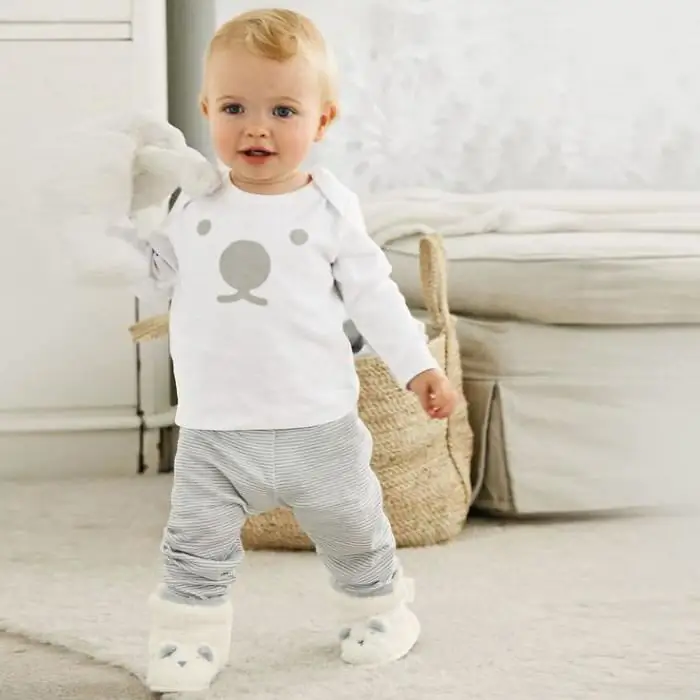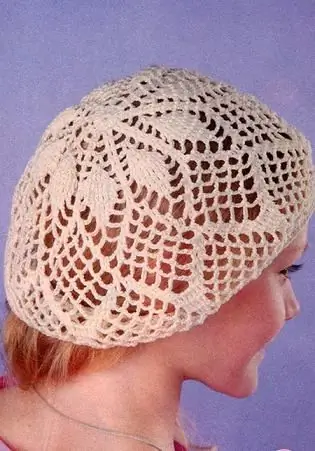
Inhaltsverzeichnis:
- Autor Sierra Becker [email protected].
- Public 2024-02-26 04:45.
- Zuletzt bearbeitet 2025-06-01 05:43.
Muster zum Stricken eines Netzes mit Stricknadeln helfen bei der Herstellung schöner handgefertigter Produkte. Diese Modelle sind seit vielen Jahrzehnten führend in der modernen Mode und heute besonders relevant. Leichte T-Shirts, Pullover, Tuniken und andere originelle Artikel werden die Sommergarderobe von Frauen und Männern schmücken. Und ein Mesh-Fragment in Form eines Kleidungsstücks eignet sich zu jeder Jahreszeit für ein stilvolles Modell.
Einfaches Raster
Dieses wunderschöne Maschenstrickmuster ist auch für Anfänger einfach zu verarbeiten und schmückt jedes Produkt. Um dieses Stricken durchzuführen, müssen Sie keine Reihen und Maschen zählen, Sie müssen nur das Arbeitsprinzip verstehen. Das attraktivste Muster wird aus Baumwoll- oder Leinengarn aussehen, aber Wolle und Wollmischungen funktionieren auch (wenn es ein Teil von Halbsaisonkleidung ist). Die Schritt-für-Schritt-Anleitung sieht so aus:
- Rapport ist nicht auf eine bestimmte Anzahl von Schleifen und Reihen beschränkt,am besten eine gerade Maschenzahl.
- Entfernen Sie in der ersten Reihe die Randmasche, stricken Sie alle Maschen von vorne und schließen Sie mit der letzten linken Masche ab (damit sich der Stoff nicht dehnt, müssen Sie die erste und letzte Masche wie oben beschrieben stricken).
- Die zweite Reihe ganz nach links ziehen.
- Die dritte Reihe beginnt mit 2 Maschen rechts zusammengestrickt und 1 Umschlag. So weitermachen bis zum Ende der Reihe.
- Die vierte Reihe, wie alle geraden Reihen, mit Linksmaschen stricken.
- Wiederhole das Muster aus der dritten Reihe.

Reverse Mesh
Der Unterschied zwischen dieser Art von Maschenware, deren Beschreibung der vorherigen Version ähnelt, besteht darin, dass in diesem Fall das Muster auf der falschen Seite angezeigt wird. Eine Schritt-für-Schritt-Anleitung zur Beschreibung der Arbeit erleichtert das Nachvollziehen des Musters:
- Rapport ist auch nicht auf die Anzahl der Schleifen und Reihen beschränkt.
- Die erste Reihe muss gestrickt werden.
- Die zweite Reihe mit zwei Linksmaschen beginnen, die zusammengestrickt sind, dann einen Umschlag machen und das Muster noch einmal wiederholen.
- Die dritte Reihe, wie alle ungeraden, mit Gesichtsschlaufen stricken.
Ausgefranstes Netz

Das gestrickte Netz, dessen Schema unten vorgestellt wird, zeichnet sich durch Zartheit und Leichtigkeit aus. Es kann als Kleidungsstück oder Sommermodell verwendet werden. Es sollte daran erinnert werden, dass dieses Muster fast transparent ist, sodass Sie eine Hülle oder verwenden könnenBeschichtung. Die Arbeit wird wie folgt erledigt:
- Rapport besteht aus Maschen in Vielfachen von sechs plus zwei Randmaschen.
- Erste Reihe - eine Masche rechts, Umschlag, zwei Maschen rechts mit einer Masche rechts stricken, eine Masche rechts, Umschlag und zwei Maschen rechts mit einer Masche rechts stricken.
- Zweite Reihe - ein Umschlag, drei Schlaufen in zwei und einen teilen (zwei durch einen strecken), Umschlag, zwei Schlaufen zu einem mit einer Neigung nach links stricken, Umschlag und vordere Schlaufe.
- Dritte Reihe - 1 Masche rechts, Umschlag, 2 schräge M links, 2 schräge Maschen rechts, Umschlag
- Vierte Reihe - eine Schlaufe rechts, Umschlag, drei Schlaufen, von denen zwei zu einer gedehnt werden, Umschlag, zwei rechts.
- Fünfte Reihe - 1 M re, 2 M re rechts, Umschlag, rechts, Umschlag, 2 M links.
- Sechste Reihe - zwei Schleifen in einer auf der linken Seite, Umschlag, eine vorne, Umschlag, zwei in einer auf der rechten Seite.
- Siebte Reihe - eine rechts stricken, zwei Maschen in einer auf der rechten Seite, Umschlag, eine rechts stricken, Umschlag, zwei in einer auf der linken Seite.
- Achte Reihe - drei Maschen in einer, Umschlag, drei Maschen rechts, Umschlag.

Denges Netz

Das Muster des Netzes mit Stricknadeln, dessen Schema unten dargestellt ist, eignet sich für wärmere Dinge (obwohl Sommer aus Baumwollstoffen nicht weniger attraktiv aussehen). Es kann ein schönes Kleid, ein Pullover, ein Schal, ein Umhang usw. sein. Gestrickt wird wie folgt:
- Rapport besteht aus zehn Schlaufen, passt mitvon der ersten bis zur zehnten Reihe, dann ab der dritten wiederholen.
- Erste Reihe - 1 Masche links, 2 Masche rechts, 2 Masche links, 1 Masche links.
- Zweite Reihe - wie alle geraden nach Muster stricken.
- Dritte Reihe - eine Linksmasche, zwei Maschen nach links kreuzen, zwei Linksmaschen. Eine li.
- Fünfte Reihe - 1 Masche rechts, doppelter Umschlag (1 Masche rechts, 1 Masche links), 1 Masche ziehen, 2 schräg nach links rechts stricken, 1 Masche rechts.
- Siebte Reihe - einmal rechts, zweimal links, von zwei nach links kreuzen, einmal rechts.
- Neunte Reihe - eine vorne, eine Räumnadel, zwei Schlaufen in einer auf der linken Seite, eine vorne.

Durchbrochen
Durchbrochenes Netz mit Stricknadeln, dessen Schema unten dargestellt ist, eignet sich für Sommer- und Nachsaisonmodelle. Die Schritt-für-Schritt-Anleitung lautet wie folgt:
- Rapport besteht aus 23 Schleifen.
- Erste Reihe - 2 Maschen links, Umschlag, 2 zusammen (erste M gewendet), 1 Masche rechts, 2 Umschlag zusammen, 1 Umschlag.
- Zweite Reihe und alle geraden Reihen wie Maschenmuster stricken.
- Dritte Reihe - zwei Maschen links, eine Masche rechts, Umschlag, drei vertauschen und rechts stricken, Umschlag und eine Masche rechts.
- Ab der fünften Reihe wiederholt sich das Muster, beginnend mit der ersten Reihe.

Durchbrochene Kante
Durchbrochenes Netz mit Stricknadeln, dessen Diagramme und Beschreibung in diesem Artikel vorgestellt werden, eignet sich eher für Produkte außerhalb der Saison. Es kann mit Fäden gemacht werdenBaumwolle (dies wird eine leichtere Version sein), Wollmischung oder Wolle. Die Hauptbedingung ist das Fehlen von Flor auf dem Garn, da in diesem Fall das Muster nicht so sichtbar ist, wie es ursprünglich beabsichtigt war. Die Schritt-für-Schritt-Anleitung sieht so aus:
- Rapport besteht aus dreißig Schleifen.
- Die erste Reihe wird mit Gesichtsschlaufen gestrickt.
- In der zweiten Reihe wechseln sich die Umschläge mit zwei zusammengestrickten Maschen ab.
- Dritte Reihe - 1 re, Umschlag, fünf Maschen rechts, drei Maschen rechts zusammenstricken, umdrehen, fünf Maschen rechts, Umschlag, eine Masche rechts, nochmals Umschlag.
- Vierte Reihe ganz links

Gitter mit Diagonalen
Das gestrickte Netz, dessen Beschreibung unten dargestellt ist, ist universell für jede Jahreszeit. Die Arbeit wird wie folgt erledigt:
- Rapport besteht aus zwölf Schleifen.
- Erste Reihe - eine Linksschleife, zwei Linksschleifen überkreuzen, zwei Linksschleifen.
- Zweite Reihe - abwechselnd eine vordere Schleife, zwei linke und zwei vordere.
- Dritte Reihe - zwei Maschen rechts stricken, einen doppelten Faden über zwei Maschen ziehen, eine nach links, zwei Maschen eine nach rechts.
- Vierte Reihe - 1 links, 1 rechts, 1 häkeln, 2 links.
- Fünfte Reihe - 1 Masche rechts, 2 Maschen links, 2 Maschen links kreuzen.
- Sechste Reihe - abwechselnd eine linke, zwei Gesichts- und eine linke.
- Siebte Reihe - eine Häkelarbeit, zwei Schleifenstricke eine nach links, zwei Maschen von einer nach rechts, Stäbchen häkeln.
- Achte Reihe - eine Gesichts-, zwei linke, eine Gesichts- und eine gekreuzte Schleife.
Gestrickte Netze, deren Schemata Sie in diesem Artikel berücksichtigen könnten, werden dazu beitragen, Ihre Garderobe stilvoll und originell zu gest alten. Neben Kleidungsmodellen aus Netzen können Sie Sommertaschen, Servietten, Vorhänge, Tischdecken und andere Produkte mit solchen Mustern dekorieren. Nach diesem Prinzip können Sie versuchen, mit Ihren eigenen Händen verschiedene Kugeln und Haarschmuck herzustellen. Es wird empfohlen, das Garn durch dekorative Garne oder Bänder zu ersetzen.
Empfohlen:
Muster eines Kinderpyjamas für einen Jungen und ein Mädchen: Beschreibung, Diagramm und Empfehlungen

Was ist der Schlüssel zu guter Laune und Fröhlichkeit für den ganzen Tag? Gesunder und fester Schlaf. Deshalb müssen sich sowohl Kinder als auch Erwachsene mit maximalem Komfort entspannen, gekleidet in sanfte und weiche Pyjamas. Muster von Kinderpyjamas, Empfehlungen für die Auswahl von Stoffen und Farben - das alles finden Sie in diesem Artikel
Heißer Häkelstand: Diagramm, Beschreibung, Muster

Für die Herstellung heißer Häkeluntersetzer wird jedes Muster verwendet. Es ist ratsam, geeignete Fäden und ein Strickmuster auszuwählen und sich dann an die Arbeit zu machen. Hot Pads können rund oder quadratisch sein. Sie können ein durchbrochenes Muster wählen
Gestrickte Katze: ein Diagramm mit einer Beschreibung

Strickkatze ist ein beliebtes Spielzeug für Kinder und Erwachsene. Sie können eine Katze in Form eines Kissens oder einer Rassel häkeln. Mit dieser Technik können Sie jede Bewegung übertragen und jede Zeichentrickfigur "kopieren". Das können riesige Katzen oder kleine Amiguri sein. Wählen Sie Ihre Lieblings-Meisterklasse und stricken Sie Ihre Katze
Durchbrochenes Häkeln: Diagramm und Beschreibung. Durchbrochene Sommerhäkelarbeit

Willst du eine durchbrochene Baskenmütze häkeln? Das Schema und die Beschreibung eines solchen Modells sind recht einfach und erfordern keine besonderen Kenntnisse und große Erfahrung von der Handwerkerin. Blumenhüte sind besonders beliebt. Sie sind für Fashionistas jeden Alters geeignet. Baskenmützen mit Ständer eignen sich für Frauen mit rundem Gesicht, Mädchen mit ovalem Gesicht können jedes Modell stricken
Häkeln: Diagramm und Beschreibung

Schema für einen Kopfschmuck für kühles und sommerliches Wetter, eine Motiv-Baskenmütze für Mädchen und einen Einteiler mit Schirm für Jungen. Die Anleitung ist auch für Anfänger einfach und verständlich
